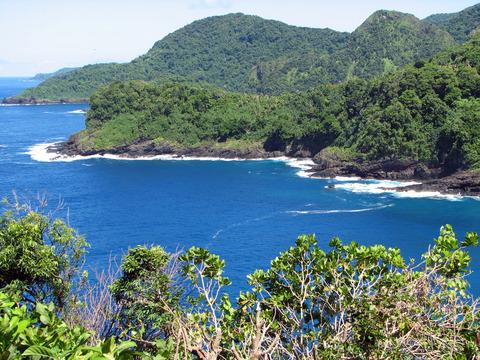A tiny clutch of islands in the South Pacific harbors not only the National Park of American Samoa, one of the National Park System’s oft-overlooked delights, but also some of the last vestiges of a colorful bird that long has captivated those lucky enough to spy it.
The park’s rugged and rumpled 9,000 acres, which are spread across the islands of Tutuila, Ofu, and Ta’u, are dotted with stunning tropical rain forests, coral reefs, and shimmering beaches. Appropriately enough, the park is home to a breathtaking variety of creatures, among them the Many-Colored Fruit Dove, or manuma, as it is known in the Samoan language. The dove, a member of the columbidae family, is only about the size of a robin, but it is a truly beautiful Samoan delight.
The manuma’s English name derives from the obvious: it is a many-colored dove that eats fruit. Cousin to the fruit doves on Fiji and Tonga, the manuma of American Samoa is a gorgeous bird that feasts on the fruits of the aoa, or banyan tree (also known as the strangler fig), although it will sometimes eat the moso'oi or magele fruits. The male is a bold, vibrant, feathery display of white, crimson, yellow, and purple, whereas the female is a more subdued green and grey. To see what these birds look like, visit this site.
The manuma is a somewhat enigmatic species. During the European expeditions of the 19th and 20th centuries it was seen to gather in giant flocks that would feed together. (In 1923 a scientist killed 10 of the birds with one shot as they ate from the aoa trees on the island of Ta'u.) These days the birds gather in smaller flocks and are becoming increasingly territorial. Only about 50 are left in all of American Samoa.
Given that so few of the birds are still around on U.S. territories (there are larger flocks elsewhere in the South Pacific), it is not surprising that the U.S. Fish and Wildlife Service has several times designated the manuma a candidate for Endangered Species Act listing. The bird has never been federally listed, however, and in 2006 the FWS removed the manuma from the candidate list. In a press release the FWS stated that “The Many-Colored Fruit Dove was removed [from listing candidacy] because the stable distribution of the species...suggests that the threats to the species are not having a detrimental effect.”
Alarming though it may be, the manuma's population decline has a positive facet. American Samoa's population of manuma eats aoa fruit almost exclusively, so it would be a calamity if the manuma population were large enough to deplete the available supply of aoa fruit. Of course, if the supply of aoa fruit were to plummet for any reason, it could be disastrous for the birds.
In the early 1990s, Hurricanes Ofa and Val came very close to being the manuma's downfall in American Samoa The storms took a terrible toll on the aoa trees, and the birds have not been seen in large groups since then. There are places on the island of Tutuila where manuma are regularly seen, but the bird is considered rare and localized in American Samoa. Today the manuma is much more common on Fiji and Tonga.
The manuma, which typically is found in the canopy of forests and which incubates one or two pure white eggs on a small fragile platform of twigs, remains a special part of the unique fabric of life in the Samoan islands. It is officially protected from hunting and other direct threats, and it is hoped that increased education efforts will yield more manuma-friendly forestry practices. The danger of losing its food supply – the aoa trees – remains very real for the colorful bird. If enough trees are cut down, damaged, or blown over, the manuma of American Samoa may starve and disappear. But with increased vigilance and a bit of luck, the Many-Colored Fruit Dove will be around for many years to come, captivating those who glimpse it in the thick forests of American Samoa and capturing the imagination of wildlife enthusiasts across the globe.




Comments
Chance,
Nice story on an interesting bird. I enjoyed it!
Thanks, Joe
Nice article and well written. Thanks.